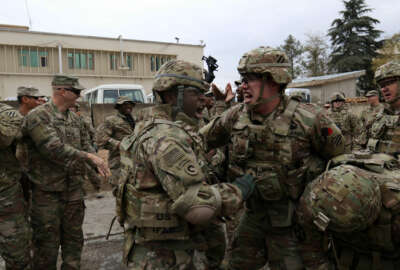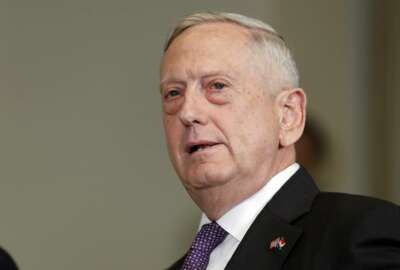
What’s in store for personnel and readiness in 2018?
Lawmakers and military analysts weigh in on the most important personnel and readiness issues for 2018.
Military personnel and readiness issues are getting some traction in Congress, but will it be enough to make it into the 2019 legislative agenda?
The 2018 defense authorization bill already calls on the Defense Department to study some possible changes to the military personnel system.
The law asks DoD to conduct a comprehensive review of the impacts of the Defense Officer Personnel Management Act, the 1980 law that defines most of today’s promotion policies for officers.
Lawmakers ordered DoD to conduct a statistical analysis, based on surveys of people leaving the military, of the effects the current policies are having on recruiting, retention and career development. The Pentagon report is supposed to include an estimate of the number of officers who depart the armed services each year because of unhappiness with “career progression, promotion policies and a perceived lack of opportunity for schooling and broadening assignments.”
Last month, Senate Armed Services Chairman John McCain (R-Ariz.) called the current DOPMA-based rules “outdated” and “overly rigid,” partly because of their across-the-board enforcement of training requirements and an up-or-out approach to military officer promotion and retention.
“One of today’s most pressing personnel challenges is the worsening pilot shortage. We’ve heard over and over that flying time and career stability are crucial to solving this crisis. Yet, DOPMA-driven personnel policies require pilots to assume numerous staff assignments, relocate every two-to-three years, and complete military education courses, all in order to be promoted according to inflexible timelines,” McCain said. “All of this is done to turn every officer into the military’s next general or admiral. Well, not every officer wants or needs to be a general officer, and it’s about time we figured out how to provide for more variety in military careers.”
Meanwhile, restoring readiness has been a goal of the Trump administration since the president took office.
To find out how things may pan out for 2018, Federal News Radio asked lawmakers and military analysts to give their predictions for personnel and readiness.
What are the biggest personnel and readiness issues facing the military in 2018?
Brad Carson, former DoD acting undersecretary of defense for personnel and readiness:
“I think the biggest P&R issues in 2018 will be, on the personnel side, recruiting. The economy is robust, unemployment is down, most young people aren’t eligible to enlist: this spells a recruiting issue. The Army is already talking about allowing marijuana waivers and they lowered the waiver authority for behavioral health conditions (since reversed after public outcry). The Army is always the bellwether. Other services will have similar issues, and the Air Force already is, what with the pilot shortage that they face. On the readiness front… this is a continued issue. Most of the services say they have readiness problems; Defense Secretary Jim Mattis and the other chiefs have said readiness is their top priority. So making it happen, given that it is a multi-year process, will be a huge effort.”
Dan Grazier, military fellow at the Project on Government Oversight:
“It is a lot of the same general issues. The force continues to be stretched too thin with far too many commitments and not enough structure. This can only be fixed at the highest levels by reducing some of our overseas commitments. The services really need to get better at focusing on core competency and eliminating less essential training requirements. It is difficult to understand how burdensome all of the mandatory training our troops endure really is unless it is experienced up first hand.”
House Armed Services Committee Ranking Member Adam Smith (D-Wash.):
“One of the most important issues will be figuring out how to deal with the end-strength requirements. This is a big issue. It’s very dangerous to put the military in a position where we’re mandating large increases in the number of troops and then don’t provide the resources to support that increase. You have to have a balanced approach that ensures the force growth is also properly trained, equipped, and sustained. Otherwise you’re creating a hollow military, and that’s the absolute last thing we should be doing.”
House Armed Services Personnel Subcommittee Ranking Member Jackie Speier (D-Calif.):
“I’m increasingly concerned about misbehavior and lack of accountability in the senior ranks. It seems like not a week goes by without a report about a general or flag officer who’s been caught engaging in sexual misconduct, conflict of interest, fraternization, misuse of government resources…the list goes on. More often than not, these officers get off with a slap on the wrist. They keep their pension, they keep their health care, they keep their security clearance and go on to a lucrative civilian career as a contractor. As the most senior leaders in our military, general and flag officers set the example for hundreds of thousands of junior officers and enlisted troops. Congress must focus on how to improve the culture and better hold senior officers accountable, no matter how many stars they wear on their shoulders.”
What issues do you think Congress will focus on for personnel and readiness in the coming year?
Jim Perkins, executive director of the Defense Entrepreneurs Forum:
“I think that vehicular readiness is going to get addressed quite seriously in the next year. The combination of excessive requirements and a no fail mentality has had tragic consequences for all of the services, most notably the Navy and Army. These fatal accidents are likely going to receive Congressional scrutiny.
Most service members probably care deeply about this particular aspect of readiness. If trust is broken at the expense of “readiness”, then you’ve sacrificed something vital in exchange for nothing and that rots a unit’s effectiveness from within.
I’m hopeful, but not optimistic that Congress will resume talks of personnel management reform. The Force of the Future initiative under Secretary Carter and Acting USD-P&R Carson was killed for political reasons, not policy. Congress wants to support national security and save money, so I have reason to believe that it will resurface in 2018.”
Speier:
“Sexual harassment and assault continues to be pervasive throughout the military, and I’ve heard too many horror stories of women – and men – who have suffered at the hands of their brothers and sisters in arms when all they want to do is serve their country. I am particularly concerned about rampant abuse at the Academies, where the next generation of military leaders are groomed. Congress will need to examine whether additional reforms are required to the military justice system, and whether existing training programs are having any impact.”
Smith:
“There are a lot of questions we need to answer: What is the plan for the long-term growth of the services, to meet what requirements? How much growth can the services achieve in the current recruiting environment? Is that growth affordable?
“And, of course, where do we find the money? We need a predictable budget to support these requirements, and we need to lift the budget caps and get our fiscal house in order. We also need a coherent, realistic national security strategy that matches what we’re asking the military to do with the size of the force and the resources we can provide to support that force.”
What issues do you think are most important to the troops?
Speier:
“I honestly believe that troops do not want to give any thought to military personnel issues – they want to stay focused on their mission. That’s the deal we made with them when they signed up for the military – they look after us, and we look after them. If troops are worried about their health care, retirement, or having an environment free from harassment or discrimination, then we’re not doing our job as a Congress.”
Grazier:
“The troops generally join the military to be soldiers, Marines, sailors, and airmen. They just want to do their jobs and have a reasonable work-life balance. They are eager to deploy and serve their country for a worthy cause and to train hard when they are back at their home stations. That becomes difficult when their time at home is packed with administration and constant permanent change (PCS) of station moves.”
Carson:
“I think pay and benefits are the most important things to the troops – plus PCS rotations and duty assignments. So a close eye will be had by the service members on pay raises, health care costs, commissaries and exchanges. Some of the services are trying to reduce the churn of perpetual moves by looking at less frequent PCS. That’d be good.”
Read more of the DoD Personnel Notebook
Copyright © 2024 Federal News Network. All rights reserved. This website is not intended for users located within the European Economic Area.
Scott Maucione is a defense reporter for Federal News Network and reports on human capital, workforce and the Defense Department at-large.
Follow @smaucioneWFED





